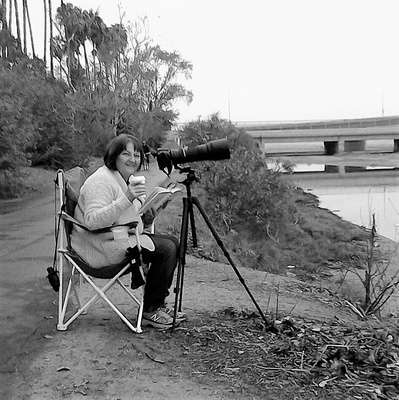"I wish I brought the other lens"
As a nature photographer of birds, insects, occasional plants, mammals, and reptiles, it is hard to leave the house in the morning, because one big decision I need to make is what equipment to bring. Of course there are many factors that go into that decision, and I try to anticipate what I will see and what I want to do. However, inevitably, at some point during the day I say either to myself, or more often out loud, "I wish I brought the other lens." Here are some of my thoughts about what I carry.
My main camera is a Nikon D7100 (24.1-megapixel DX-format CMOS image sensor). I recently bought a second body as a spare with a slightly different strap configuration. I don't carry them both at the same time, but may pack them in the car if it is for a longer trip. I also have a point-and-shoot Nikon Coolpix P300 which slips neatly in a pocket. I frequently carry it to shoot pictures of the habitat. My phone is not the most high tech and so is not good for photos. I may change that in the future. I carry a spare camera battery. The camera has two slots for SD cards. This has been handy for when I forget to put one back in after loading the previous batch of photos to my computer.
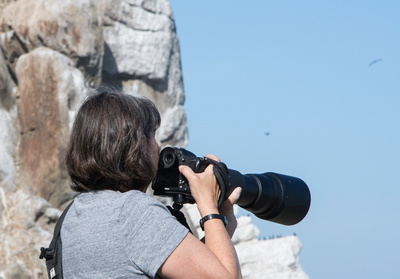 Tamron 150 to 600mm lens. BlackRapid shoulder strap. Cotton Carrier hand strap.
Tamron 150 to 600mm lens. BlackRapid shoulder strap. Cotton Carrier hand strap.
I mostly shoot handheld. If I am going birding then I will bring my Tamron 150 to 600mm lens. I carry it with a BlackRapid shoulder strap attached to the tripod mount.
The camera and lens are pretty heavy, so I use it for shorter walking distances (max about 2 miles). I have tried a monopod but it has never been successful for me. Many birds are in the trees or flying at different angles, and I often need to grab my lens quickly. The monopod has not been helpful in these situations and just adds weight. I have yet to feel comfortable with it.
If I am going to sit and watch birds, I will probably be close to the car. In addition to the big lens, I have a rolling cart and can carry a tripod, chair, scope, bird book, and a thermos of coffee. I take the strap off and put the lens on the tripod. I have done this when studying gulls. It was a very satisfying experience.
If I'm shooting insects, I'll bring my Tamron 90mm macro lens with a Nikon SB-800 AF Speedlight and a Fotodiox 6"x9" Softbox. Again I shoot handheld. This too can get heavy. If I am walking with it, I will use my Cotton Carrier camera harness. I sometimes add a Raynox DCR-150 Snap-On Macro Lens for really tiny critters.
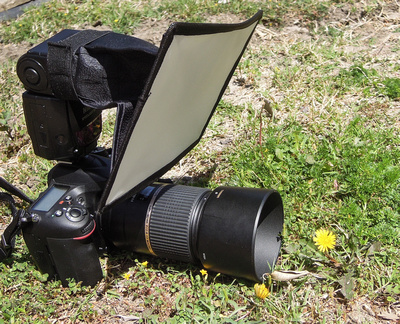 Macro setup
Macro setup 
If it's a longer walk, I will bring my Nikkor 70-300 VR zoom lens. I wear my camera harness. This leaves me hands-free when I need it and gives me a break from carrying the camera in my hand. The drawback is that it is difficult to maintain good posture. I also carry the point-and-shoot and the Raynox snap-on macro. This setup is very versatile for shooting birds, macro, and habitat. It is probably the one I use most often. It is good for 'documentation' photographs and an occasional really nice one. I was happy I had this for my 3 1/2 mile butterfly survey. I could catch butterflies from a distance so that they wouldn't spook, and add my Raynox for close-ups, and it was a perfect lens for a gopher snake that was sunning itself in the middle of the trail.
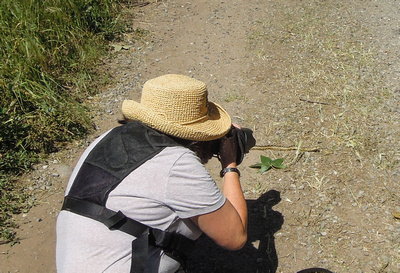 Nikkor 70-300 VR zoom lens. Cotton Carrier camera harness. This photo was shot by a friend with my Nikon Coolpix P300.
Nikkor 70-300 VR zoom lens. Cotton Carrier camera harness. This photo was shot by a friend with my Nikon Coolpix P300.
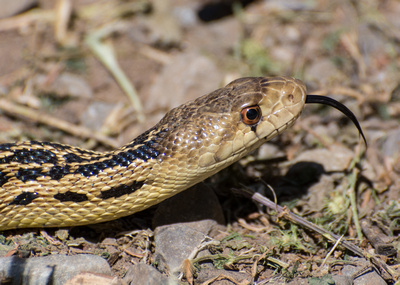 Nikkor 70-300 VR zoom lens.
Nikkor 70-300 VR zoom lens. 
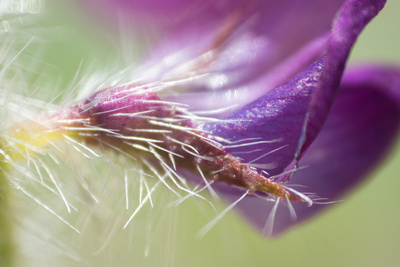 Shot with Nikkor 70-300 VR zoom lens with Raynox DCR-150 Snap-On Macro
Shot with Nikkor 70-300 VR zoom lens with Raynox DCR-150 Snap-On Macro
On some occasions, not on long walks, I bring my Sigma 15mm f/2.8 EX DG Diagonal Fisheye lens or Nikon AF-S DX NIKKOR 18-105mm zoom lens. These are good for landscape and other shots. I always carry my tripod in the car and I sometimes use it with these lenses for night shooting.
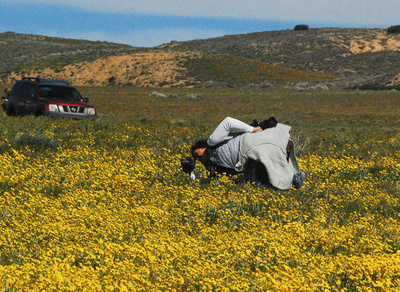 Shooting with my fisheye lens
Shooting with my fisheye lens
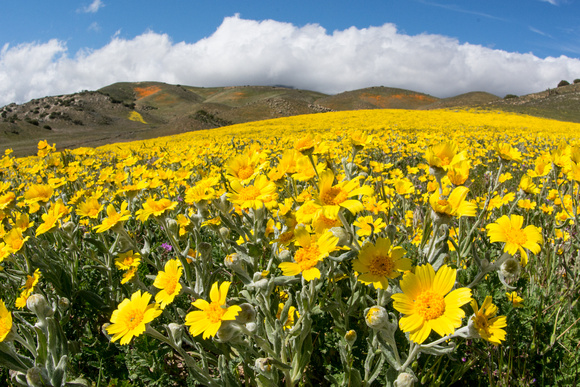 Shot with Sigma 15mm f/2.8 EX DG Diagonal Fisheye lens
Shot with Sigma 15mm f/2.8 EX DG Diagonal Fisheye lens
Somehow, I always wish I had the other lens, but I don't let the lens restrict what I shoot. Recently birding in Sycamore Canyon in Whittier, I had my big lens. There were many insects I would like to have shot, but missed. However, I still got decent shots of butterflies. At Madrona Marsh, I shot a Red-tailed Hawk being harassed by a Red-winged Blackbird, with my macro lens because that is what I had when the action occurred. I would have loved to have my big lens. Another time, at Tejon Ranch, when I had my macro lens, I saw a rattlesnake. Oh how I wished I had a longer lens. As I gained some bravery, and the snake seemed not to pay too much attention to me, I crept closer to get a better shot. But when I used my flash and got a little too close, he gave a little rattle and I ran very fast.
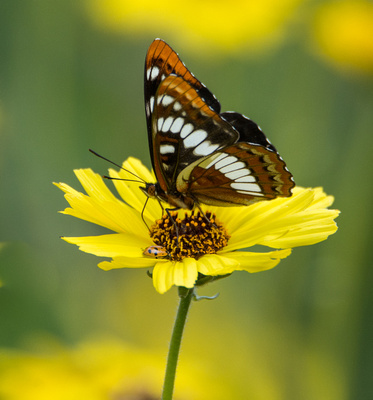 Shot with Tamron 150 to 600mm lens
Shot with Tamron 150 to 600mm lens
 Shot with Tamron 90mm macro lens
Shot with Tamron 90mm macro lens 
Another decision in carrying gear is where you are going in terms of safety. I often go out alone, but only to certain places where I feel safe. The longer the lens, the more attention I get. Often it's somebody asking if I'm a birder and then they proceed to tell me about a bird that they have recently seen. That's good attention, and I enjoy talking with them on the trail and educating people on birds. However, sometimes there's attention you don't want, and I feel it may make me a target. Sometimes if I'm carrying the big camera in a sketchy neighborhood I will wear a poncho to cover it up or, better still, to go with a group. When I become absorbed in shooting, I am not always aware of my surroundings. I have been approached for 'money'. In one experience I had a bare-chested, bald, tattooed man wearing nothing but shorts and flip-flops and carrying a can of beer say "That camera looks expensive." I responded "I don't know, it was a gift". That made my heart skip a beat. Fortunately, although I separated from them, I was with a group and someone from my group came to my side. Nothing happened and perhaps he was just curious about getting into photography, but it makes me more cautious.
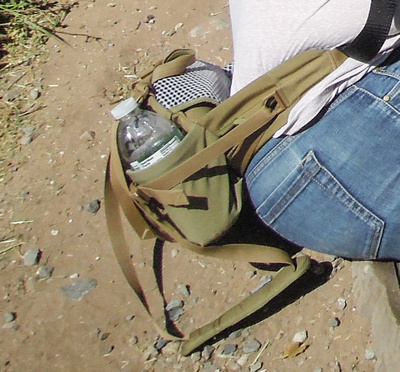 My favorite day pack
My favorite day pack Camera, lens, and carrying method are not the only decisions to be made. I almost always carry Pentax 8.5x21 U-Series Papilio II Binoculars. They are close focusing and are good for birds and bugs. I have a favorite daypack, which also functions as my purse. It is a Mountainsmith Drift Lumbar Pack and is a good size for carrying smaller lenses, a journal, a water bottle, and various other essentials. I like that it converts from a shoulder bag to a fanny pack.
Camera, lens, and carrying method are not the only decisions to be made. I almost always carry Pentax 8.5x21 U-Series Papilio II Binoculars. They are close focusing and are good for birds and bugs. I have a favorite daypack, which also functions as my purse. It is a Mountainsmith Drift Lumbar Pack and is a good size for carrying smaller lenses, a journal, a water bottle, and various other essentials. I like that it converts from a shoulder bag to a fanny pack.
And, of course, I have other decisions to make such as, which shoes, hat, water bottles, snacks, lunch, and clothes (long or short sleeves, shorts or long pants, sweater?). Sometimes I like to bring my journal and small watercolor kit. Whatever I decide, it is always not enough and too much to carry!
Intense birding people often are less interested in stopping for photography, much less for an insect. It's not just the right gear that is needed, but also going with the right people and then choosing the gear for the group. I went birding at Madrona Marsh one week and there were so many insects that I had to make a second trip with friends from my entomological society and my macro lens.
Whatever I choose, the most important thing is to always carry a camera, and I'm sure that you will hear me say, "I wish I brought the other lens".
